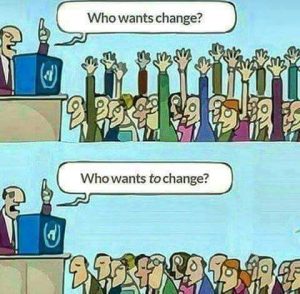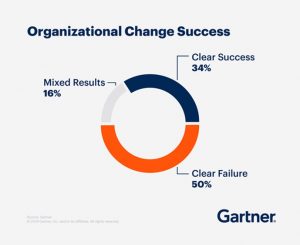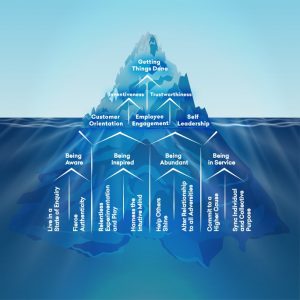Organizational Change Management: A Definitive Guide

Table of Contents
What is Organizational Change?
Organizational Change Management
Types of Organizational Change
Why Organizational Change is Inevitable?
Most organizational change initiatives fail to deliver value
Human Potential Methodology for Organizational Change
Examples of Organizational changes implemented by Being at Full Potential
Our Learnings from Leading Organizational Change and Development in workplaces
Resources on Organizational Change
Frequently Asked Questions

What is Organizational Change?
Corporate organizations change one form or the other regularly to achieve better results. Whether it is strategic or operational, organizational change has a profound impact on the direction, composition, roles, and responsibilities of the individual employees. Organizational change is a process that is often initiated by the managers to implement changes in a manner that meets the objectives stipulated by the organization.
With any organization, change is inevitable. And though change may sometimes be difficult to deal with, it is crucial to the growth, development, and progress of an organization. This is most commonly achieved by major initiatives, such as a merger, restructuring, or divestiture of a business unit. Other examples include re-engineering of the information technology infrastructure or a restructuring of the corporate organizational chart.
The other term that is often used synonymously with organizational change is ‘change management’, which refers to the planning and control of the process of change within an organization.
Organizational Change Management
The key to successful organizational change management lies in the engagement of all employees and the buy-in from their managers. It is important to involve the stakeholders from the very beginning and to communicate intentions and goals. This can be done through town hall meetings and regular communication.
Another important part of change management is collaboration. It is crucial that people are working together to achieve the organization’s goals, rather than getting in each other’s way. Finally, it’s important to reward employees for their hard work. This sends a clear message about the importance of the change and gives people incentives to keep up great work.
Change can be difficult to manage. Even the most confident leaders can feel uncomfortable with change, and there’s a multitude of reasons for why that is. It can be a matter of uncertainty, fear, or a combination of both. If you are a change management professional, it’s important to note that you are not alone in this and it’s up to you to help others adapt to change.
Types of Organizational Change
There are many reasons why organizations decide to change the way they do business. This process can be initiated by the organization itself or by an outside agent. This can occur due to cultural, social, behavioral, or technological changes. Organizational change can be a necessary and vital part of maintaining organizational health and growth.
In the business world, change is often necessary to remain competitive and to meet the needs of a dynamic marketplace. Change is often a welcomed part of life and is generally a good thing. However, not all change is good and some organizations have a difficult time adapting to change.
The types of Organizational Change include,
- Strategic Transformational Change
- Structural Change
- Remedial Change
- People-Centric Organizational Change
Learn more about the types of Organizational changes in detail here
Why Organizational Change is Inevitable?
Change is an inevitable part of every business, especially in today’s VUCA world. It is the primary source of growth in organizations. It is also an integral part of any business strategy. But change is not limited to the growth and development of a business strategy. It also applies to the growth and development of organizations in general. Organizations are not static; they are dynamic and ever-changing. Every organization has the potential to grow and develop. This is what we call organizational change. Sometimes it is caused by external factors, and other times it is the result of internal factors. Regardless of what triggers it, it is important to understand that every organization has to face the issue of change. And when it comes to organizational change, the question that comes to the forefront is how organizations change.
Change is not necessarily a bad thing. It can be an excellent opportunity to learn and grow. It can bring out the best and the worst in people. But not everyone understands how to handle change. Today’s world is VUCA (Volatile, Uncertain, Complex, and Ambiguous), and here is an article helping us better understand how to handle organizational change.
Why do most organizational change initiatives fail to deliver value?

The growing rate of change has given birth to more complex business environments. For organizations to thrive in this high-speed ecosystem, they need to be able to embrace change effectively. The Gartner research shows that only 34% of the changes were considered a clear success. This is compared to 50% clear failures. The key to increasing the success rate of an organizational change is ensuring its alignment with the business strategy and the development of a high-performance culture.
“Organisational change initiatives can be a success in improving the business only if they are driven by the core business drivers. We recommend that the following four drivers must be present for a successful organizational change process,” said Andrew Huxley, VP, and Fellow at Gartner
According to a McKinsey article, most change/leadership/culture initiatives fail to deliver because we don’t work at the MINDSET level
“Becoming a more effective leader often requires changing behavior. But although most companies recognize that this also means adjusting underlying mindsets, too often these organizations are reluctant to address the root causes of why leaders act the way they do. Doing so can be uncomfortable for participants, program trainers, mentors, and bosses—but if there isn’t a significant degree of discomfort, the chances are that the behavior won’t change.
Identifying some of the deepest, “below the surface” thoughts, feelings, assumptions, and beliefs is usually a precondition of behavioral change—one too often shirked in development programs. Promoting the virtues of delegation and empowerment, for example, is fine in theory, but successful adoption is unlikely if the program participants have a clear “controlling” mindset (I can’t lose my grip on the business; I’m personally accountable and only I should make the decisions). It’s true that some personality traits (such as extroversion or introversion) are difficult to shift, but people can change the way they see the world and their values”.
– McKinsey article 2014
Human Potential Methodology for Organizational Change

Unless we work on the bottom layer and genuinely reassess our underlying belief systems and assumptions about the business and the organization we will not be able to create the sustainable changes in behavior that we are aspiring for. This is of course very daunting work. It can feel like “opening Pandora’s Box”.
Because we don’t know what will be unleashed, is it not better to keep it tightly closed?
This is certainly the feeling many people have and undoubtedly one of the reasons why deeper, human-centric HR interventions are avoided. It’s a fascinating paradox. On the one hand, addressing the bottom of the Iceberg offers the greatest hope, and on the other hand, it also triggers the greatest fear.
As stewards and thought leaders of this work, we have deep compassion for leaders who are confronted with this dilemma. It’s a scary path to take and doesn’t come without risks. However, if executed with great care, it is possible to make the self-realization journey more accessible and relevant to the organizational context.
Creating transformational tools and methods that meet organizations, where they’re at vs expecting them to take this huge leap of faith, is what Being at Full Potential is all about. By quantifying the intangibles, we help shine the light on the invisible layer of culture. HR leaders now have a practical way to measure and release the 85% of intangible value and in doing so, it is possible to start harnessing the vast creative potential of their people. In our experience, when it comes to large-scale organizational change journeys, there is no better place to start than with ourselves. As we grow in our leadership, so will we grow in our ability to inspire and engage other stakeholders throughout the organization and influence the dynamics that are at play.
Is this a challenge you are ready to take on? Do you want to courageously examine how some of your own beliefs may need to change in order to spark a deeper transformation within the organization? Let’s start with a simple exercise:
- How would an objective observer describe your behaviors at work? Would they describe you as action-oriented, a critical thinker, perfectionist, a good listener…? Take a moment to write down what comes to mind.
- Check-in with yourself where that behavior may be coming from. Is it just part of your personality or can you see that there is an unconscious belief or assumption that may be driving certain patterns of behavior? Take a moment to write down what comes to mind.
- Finally, ask yourself if there are any behaviors you would like to evolve/change for yourself in the future. And if so, is there a corresponding change at the belief or mindset level that needs to take place as well?
Examples of Organizational changes implemented by Being at Full Potential
We at Being at Full Potential recognize that the next wave of innovations is going to be unleashed by pulling the human lever. It is going to come from harnessing the human states – not systems and processes – by moving people into heightened states of awareness where they become infinitely creative.
No problem can be solved from the same level of consciousness that created it
– Albert Einstein
Take a look at how helped bring change in Omega HMS by Changing the approach to talent development from looking only at the past performance to also consider future potential
Here is an example of how we helped change the organizational culture from “command and control” to “self-leadership” in a North London Supermarket.
Learn how Being at Full Potential brought in Organizational reinvention during the Pandemic at Sacred Heart Center
Teach for America: Case Study – Organizational change starts at the individual level (ie: Being the change we wish to see in the world)
Our Learnings from Leading Organizational Change and Development in workplaces
- Location is nothing, our BEING is everything
- Infuse mysticism but don’t keep it mysterious
- Invest in BEING, unleash the DOING
- Use Human Potential DATA to break open conversations and unlock new thinking
- No matter how profound the collective experience is it needs to be accompanied by ongoing work at the individual level in order to sustain itself
We have explained in detail about these 5 Key Learnings from Leading Organizational Change and Development in Organizations here.
Resources on Organizational Change
While you are here, look at some of the other blogs related to Organizational Change, Transformations, Consciousness culture, and Unlocking Performance
